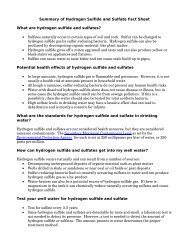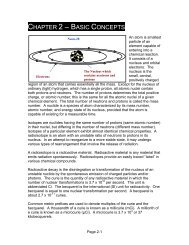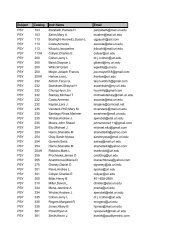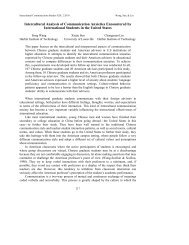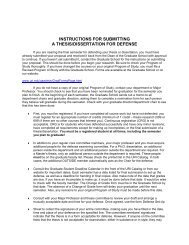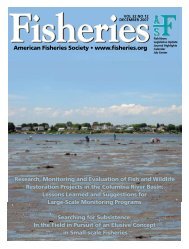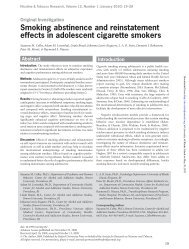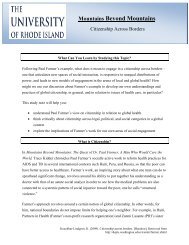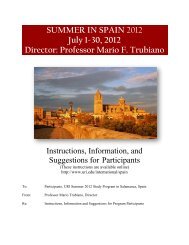Appendix A Standard Operating Procedures - University of Rhode ...
Appendix A Standard Operating Procedures - University of Rhode ...
Appendix A Standard Operating Procedures - University of Rhode ...
You also want an ePaper? Increase the reach of your titles
YUMPU automatically turns print PDFs into web optimized ePapers that Google loves.
5. Fill the autoclave with water by turning the multi-purpose value (always turn this valve<br />
clockwise) to FILL. The water should reach most <strong>of</strong> the width <strong>of</strong> the “indicator channel” at<br />
the front <strong>of</strong> the chamber. Turn the multi-purpose valve to STE to stop the flow <strong>of</strong> water<br />
and prepare the unit for sterilization<br />
6. Close the door, and lock it by turning the handle clockwise. The door should be secure<br />
with a good seal, but only “hand tight”.<br />
7. Set the temperature at 250 °F / 121 °C with the thermostat knob. This is the temperature<br />
most <strong>of</strong>ten used for sterilization. If you are in doubt <strong>of</strong> the correct autoclave temperature<br />
or time, refer to the appropriate method SOP. If you are autoclaving waste materials, refer<br />
to SOP 006 – Waste Autoclaving Procedure, for correct temperatures and autoclave<br />
times.<br />
8. Set the STE timer to the correct sterilization period. Note: this unit takes about 30 minutes<br />
to get up to temperature/pressure so be sure to factor that into your time (set the time for<br />
the TOTAL time period = +/- 30 minute “heat up” + sterilization time needed (usually > 15<br />
minutes).<br />
9. Check on the unit after about 25 minutes to be sure that it is reaching temperature /<br />
pressure. Small bursts <strong>of</strong> steam may be evident from the water reservoir during the run;<br />
this is normal and necessary. Record the unit pressure on the Autoclave Use log. It is<br />
necessary to record the maximum pressure while the unit is running because the<br />
maximum pressure needle is broken (as <strong>of</strong> 2008).<br />
10. If the unit does not reach the set temperature contact Elizabeth Herron to arrange for<br />
pr<strong>of</strong>essional servicing <strong>of</strong> the unit. Until the unit is repaired, it should not be used to<br />
sterilize materials.<br />
11. When the timer reaches 0, the run is complete.<br />
12. Turn the multi-purpose knob to EXH + DRY.<br />
13. Follow the procedure below based on desired cycle (with or without drying)<br />
Cycle without drying:<br />
1. When the pressure gauge reads 0, turn the main switch to STOP, and the multi-purpose<br />
switch to 0.<br />
2. Carefully open the door – steam will escape so do not put any body parts near the edge <strong>of</strong><br />
the door while opening it.<br />
3. Remove the load using insulated gloves and unplug the unit if you are not running any<br />
more loads immediately.<br />
4. Record the temperature on the maximum temperature recording thermometer and the run<br />
time on the autoclave run sheet. The thermometer should read at least 121 °C. If it<br />
doesn’t contact Elizabeth Herron and assume the materials taken out <strong>of</strong> the autoclave are<br />
not sterile.<br />
Cycle with drying:<br />
1. When the pressure gauge reads 0, carefully open the door slightly to let the steam escape.<br />
Leave the door closed, but not locked down with the locking screw.<br />
2. Set the timer for 20 – 30 minutes; the drying indicator lamp will light.<br />
3. After the time has elapsed, turn the multi-purpose valve to 0, the main switch to STOP.<br />
2 <strong>of</strong> 4<br />
General Autoclave Operation SOP 004<br />
S:\WW\awwword\LABPROC\all QAPPs\LABQAPPs\QAPP Rev5 -0609\SOPs\SOP 004 GenAutoclaveOps-MOD.doc



